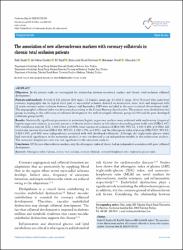The association of new atherosclerosis markers with coronary collaterals in chronic total occlusion patients

Göster/
Erişim
info:eu-repo/semantics/openAccessTarih
2022Yazar
Emlek, NadirÖzyıldız, Ali Gökhan
Ergül, Elif
Öğütveren, Muhammet Mürsel
Öztürk, Muhammet
Aydın, Cihan
Üst veri
Tüm öğe kaydını gösterKünye
Emlek, N. Özyıldız, A.G., Ergül, E. Öğütveren, M.M., Öztürk, M. & Aydın, C. (2022). The association of new atherosclerosis markers with coronary collaterals in chronic total occlusion patients. Cardiovascular Surgery and Interventions, 9(3), 152-158. http://doi.org/10.5606/e-cvsi.2022.1368Özet
Objectives: In the present study, we investigated the relationship between mentioned markers and chronic total occlusion collateral
development.
Patients and methods: A total of 243 patients (210 males, 33 females; mean age: 63.3±11.5; range, 51 to 76 years) who underwent
coronary angiography due to typical chest pain or myocardial ischemia detected in noninvasive stress tests and diagnosed with
≥1 major coronary artery occlusion between January and September 2020 were included in the cross-sectional observational study.
The angiographic collateral index was determined according to the Cohen-Rentrop classification. The patients were divided into two
groups according to the sufficiency of collateral development: the well-developed collaterals group (n=155) and the poor-developed
collaterals group (n=88).
Results: Statistically significant parameters in univariate logistic regression analysis were evaluated with multivariate (stepwise)
logistic regression analysis; as a result, presence of chronic total occlusion in left anterior descending artery (odds ratio [OR]=2.447;
95% confidence interval [CI], 1.160-5.162; p=0.019), total number of occlusions (OR=3.503; 95% CI, 1.445-8.494; p=0.006), left
ventricular ejection fraction (OR=1.056; 95% CI, 1.022-1.091; p=0.001), and the atherogenic index of plasma (OR=0.017; 95% CI,
1.022-1.091; p<0.001) were independently associated with well-developed collaterals. Although the triglyceride-glucose index
had statistical significance in the univariate analysis, it was not detected as an independent variable in the multivariate analysis.
The monocyte-lymphocyte ratio was not significant in the univariate analysis.
Conclusion: Of the new atherosclerosis markers, only the atherogenic index of plasma had an independent association with poor collateral
development

















